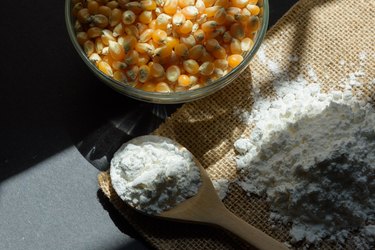
Cornstarch is usually used as a thickening agent that's added to dips, sauces and soups. The powder may also be added to processed foods either as a filler or to prevent food from losing its texture, like yogurt.
In some cases, you can use cornstarch to replace wheat flour in recipes, too.
Video of the Day
Video of the Day
Cornstarch may look and function a lot like wheat flour but for those following a gluten-free diet, the two couldn't be more different.
Related Reading
Is Cornstarch Gluten-Free?
Gluten is a protein found in wheat, rye and barley and these grains' derivatives, according to the Celiac Disease Foundation.
Cornstarch is made from refined corn and is a naturally gluten-free ingredient.
But that doesn't necessarily mean that all cornstarch is free from potential cross-contamination. Before you buy just any container of cornstarch, double-check the packaging to verify it's safe to eat.
With all gluten-free foods, cross-contamination is always a risk that you need to consider, as corn starch may be produced or manufactured in a plant that handles wheat-based flours or other gluten ingredients.
Cross-contamination happens when foods come in contact with gluten ingredients either through preparation or manufacturing, according to the Celiac Disease Foundation.
If cornstarch is stored or manufactured in the same container or area as a gluten-containing food, it might have come in contact with gluten.
Is Modified Corn Starch Gluten-Free?
Modified corn starch is a common additive in both packaged gluten foods and gluten-free foods. Most modified food starch in the U.S. is gluten-free because it's made from corn and potatoes, two naturally gluten-free ingredients, according to Beyond Celiac.
How to Find Gluten-Free Cornstarch
You can avoid any cross-contamination by checking the packaging and reading the nutrition label on the foods you buy — cornstarch included.
First, check the ingredient label and allergen listing for any wheat, rye or barley-based foods. Then, look for a "Gluten-Free" label on your cornstarch.
This label is regulated by the U.S. Food & Drug Administration (FDA) and ensures the starch you're buying is less than 20 parts per million (ppm) of gluten, which is generally safe for even gluten-sensitive individuals.
For some added reassurance, buy foods that are certified gluten-free by trusted third parties, like the Gluten-Free Certification Organization (GFCO).
The GFCO sets especially strict standards, certifying foods that comtain only 10 ppm of gluten or less, according to the organization's website.
Gluten-Free Cornstarch Products to Try
- Argo Corn Starch ($7.82 per pack of 2, Amazon.com)
- Unpretentious Baker Corn Starch ($14.28 per 3 lbs., Amazon.com)
- Rumford Corn Starch ($5.80 per container, Amazon.com)
- Clabber Gril Cornstarch ($10.85 per 3.5 lbs., Amazon.com)
Creative Uses for Cornstarch
Dietitian Bonnie Taub-Dix, RDN, creator of BetterThanDieting.com and author of Read It Before You Eat It: Taking You from Label to Table shares some helpful uses for cornstarch below.
- Use it as a thickening agent: Cornstarch can be added to soups, gravies and sauces to give them a thicker texture. Or combine it with fruit for your favorite cobbler or pie filling.
- Try it as a breading for chicken: Add cornstarch to chicken breading to boost its crunch factor.
- Try it to increase grip on sports equipment: Think of that powdery stuff bowlers put on their fingers before picking up a bowling ball or tennis players use before grabbing their rackets. Cornstarch can be used for these purposes and more.
- Use it to soothe skin: Cornstarch used to be the go-to to help prevent diaper rash for babies, much like baby powder with talc, which is not often recommended nowadays. Adding some cornstarch to water to form a paste could help sooth a sunburn or skin irritation.